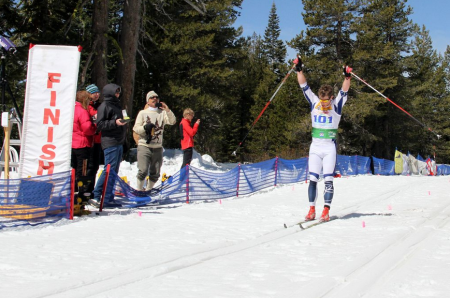
FasterSkier’s coverage of SuperTour Finals and U.S. Distance Nationals is brought to you by the generous support of Concept2, the leading manufacturer of indoor rowers, racing oars, and the SkiErg.
NORDEN, Calif. — Competitors in the U.S. 50 k National Championship knew they were in for a trying few hours at Royal Gorge as they lined their skis up on the starting line on Thursday morning. It wasn’t just a 50 k — it was a 50 k mass start classic in changing conditions at 7,000 feet. As the final test of the year for a field whose season began in November, it was the final hurdle standing in the way of post-season festivities and a few weeks off from training. Whoever would be crowned the distance national champion after two-plus hours would be the victor in a war of attrition against the course, the field, the slush and the fatigue of an entire season.
After five laps, the last man standing was one Kris Freeman (Maine Winter Sports Center/U.S. Ski Team), winner of the last two consecutive U.S. distance championships and one of the most respected skiers in the U.S for the better part of a decade. When he crossed the finish line in 2:24:52.8 he was 53 seconds ahead of longtime teammate Andy Newell (SMS T2/USST).
Freeman let his exhaustion show; after striding a sluggish finish stretch he would normally have double-poled, he raised his arms up triumphantly, grateful that such a race was finally behind him. As other finishers came through, he lay flat on his back in the snow, chest heaving.
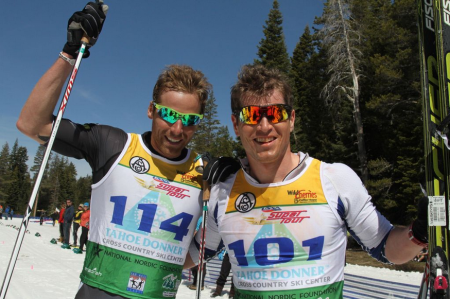
“Today was a really rough 50 k,” Freeman said. “It was so slow and so high, the combination just — I don’t think I ever felt good at any point in the race.”
He wasn’t the only one hurting. Newell said his arms started seizing with 30 k to go, and Einar Ulsund (University of Utah), who finished 29.1 seconds behind Newell in third, felt his body cramp up halfway through the race.
“I first started feeling it in my triceps, and on the fourth lap the whole system from here; everything was cramping,” Ulsund said. “It was just a fight just getting to the finish line, trying to stay with Newell and Freeman as long as possible.”
There was no getting around the altitude or the fact of the 50 k distance, but there was one defense against slow snow: a good service crew. As the first domestic championship to test out both ski exchanges and an accompanying penalty loop, Thursday’s race was also a battle of the wax techs. Most top women in the 30 k the day before opted to ignore the exchange pit, but the men’s race was different. Snow temperatures warmed significantly between the 9:00 a.m. start and the finish over two hours later, and in a 50 k skiers were bound to want fresh wax if they could get it. Anything to ease their progress through California’s slushy snow was welcome aid.
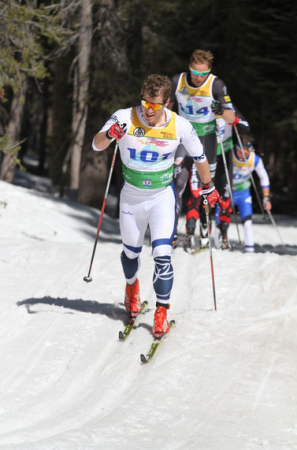
When the race got underway, the first 10 k weeded out who would likely be fighting for a podium. Ulsund, Freeman and Newell came back to the stadium for the first time with a seven-second gap on the rest of the field — small, but enough to show they were all going to be skiing well. As the snow was still relatively firm before 10:00 a.m., none of the trio stopped for new skis at the first exchange.
Behind them, Pat O’Brien (Craftsbury Green Racing Project), Rune Oedegaard (University of Colorado) and Tad Elliott (Ski & Snowboard Club Vail Team HomeGrown/USST) were spread out but conceivably still within striking distance. Erik Bjornsen (Alaska Pacific University/USST), Reese Hanneman (APU) and Torin Koos (Bridger Ski Foundation/Rossignol) followed after another small break, and since none of the leaders changed skis the first lap, they all went directly through the lap lanes without stopping.
Out in the woods for lap two, the leaders gauged each other’s ski speed and energy levels. To Ulsund, it was clear that he, Freeman and Newell were skiing better than the rest of the field.
“I knew it was me, [Freeman] and Newell probably that were the strongest guys in the field after that first hill,” Ulsund said. “After that it was more like, not being too eager to lead. Kris, he didn’t want to lead so much so I had to do a fair amount of [the] job. Newell, he helped, and Kris was mostly skiing hard in the hill.”
Newell’s strategy was simple: to follow other people and “not think about skiing 50 k’s.” In between taking pulls at the front he stuck behind Ulsund and Freeman like glue.
The size of the lead group fluctuated as skiers alternately regained contact and the dropped off the pace. O’Brien rejoined them over the next 5 k, and soon after so did Elliott. Bjornsen and Hanneman lurked another few seconds behind.
When the leaders reentered the stadium at 20 k for a second time, the snow had truly begun to break down. It was the moment that spectators, coaches and athletes had been waiting for — who would change skis, and who would keep going? The extra 150 meters it took to reach the exchange pit presented the same trade-off seen at the Holmenkollen test event on the World Cup this year. The choice to stop or not hinged on many factors in the moment: who you were skiing with, how your skis were running relative to others, and what the people around you decided to do at the fork.
With Freeman in the lead at the junction, Newell and Ulsund decided they would follow him no matter what — Freeman went left for new skis and the other two copied him. Freeman’s change wasn’t a last-minute decision: he planned on taking advantage of one change out of a possible two.
“I knew I’d probably be giving up about a minute, so I only wanted to do one ski exchange,” Freeman said. “I started on my slower skis and switched to my better skis [at 20 k], and second and third did as well.”
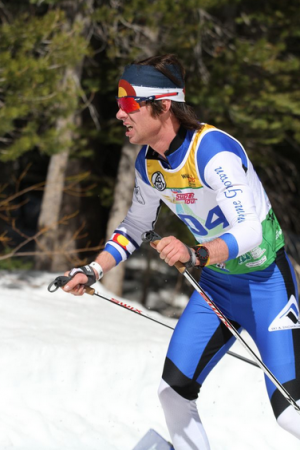
Elliott, Bjornsen and Hanneman chose the opposite track and went right back out for lap three, becoming the the new race leaders as their competitors fiddled with bindings.
“It was just my goal to ski with Bird for most of the race, so I kind of followed him into the exchange zone because I thought it’d be a good choice to ski with him and it worked out well,” Newell said.
“I just decided I was going to follow the tactic of Kris,” Ulsund said.
Elliott, as the first man not to change skis, acted on faith that his first pair would continue to run as well as they were in the first two laps. Salomon over-nighted a new pair of skis to him for the 50 k, and he thought they would still be his best option for the remainder of the race.
“Two laps in our coaches said, ‘Look, what you have on is still what we think is the best; I think you need to skip,’” Elliott said. “So I skipped and I had a gap.”
He hoped Bjornsen, who also skipped the pit, would soon be skiing with him and they could work together out in front, but help from the SuperTour Finals champion never came. Instead Bjornsen and Hanneman bunched together in second and third while Elliott plugged away alone as Freeman, Newell and Ulsund closed in on fresh gear.
“I knew my skis were good out of the pack in the beginning,” Elliott said. “I was kind of hoping that by me skipping, Bjornsen and Kris would come up, but those other guys were skiing well. Huge credit to our wax techs; they kept me in the race for a long, long time.”
Elliott held Freeman, Newell and Ulsund off for almost a full lap, to the slight surprised of the hunters. They caught Hanneman and Bjornsen first within 3 k of the stadium, but Elliott put up more of a fight.
“Tad was giving her; he took a gamble there,” Freeman said. “I kind of thought he wouldn’t change because I was slick on the first 20 k and I watched him and he was just going right up the hills. I think he probably had the best skis of the group, early. So I think it was a smart gamble he took, but once we changed we were just faster.”
After the leaders reabsorbed Elliott he hung for another few kilometers. Hanneman had been swalloed up much earlier, but after the group passed him he kept a steady pace and successfully reattached to the five-man group.
“I was kind of dangling off the lead pack, and I just decided to close the gap down as quickly as I could without going anaerobic,” Hanneman said. “And I closed it down and that was a really good call for me, because I got to sit in there with the pack then just wait for the muscles to start cramping and keep trying to improvise from there.”
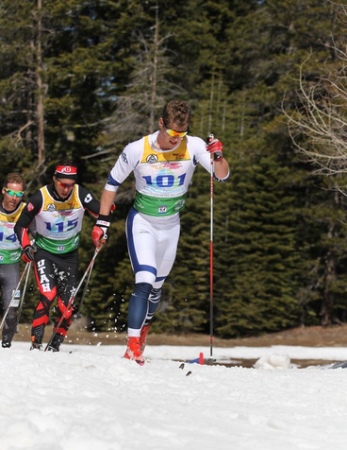
Before the end of the second lap, muscle fatigue claimed its first victim and Hanneman began to drop off the pace. Bjornsen dropped off, too, and Elliott hung on until 35 k.
By the time the lead group came back into the stadium at 40 k, it size had shrunk back to where it started: just Freeman, Newell and Ulsund.
The kilometers ticked by, the snow got warmer and sloppier, and the race was reduced to a battle of wills and endurance. Freeman has the resume to easily be considered a favorite over the other two, but Newell and Ulsund stayed with him longer than he expected.
“It was pretty cool to see Newell skiing that fast,” Freeman said. “He had me nervous for a little while… It was really hard to break away because it was way faster to go down those hills in a group. Those guys would get to yo-yo around each other. They both had good skis — as good as mine — so one would pass the other and they’d catch up to me on the downhills. So I was working my ass off for the last 8 k, double-poling down hill.”
With 6 k to go, Freeman made a decisive move, accelerating up and over the top of the major climb to finally put a safe distance on Newell and Ulsund.
“I put in a pretty hard move in the first A-climb on the course on the last lap, and I didn’t look back until I had about 30 seconds on him — and thank God,” Freeman said.
The defending champion skied away, stopping to take another feed 5 k before the finish, where his coach told him he was almost half a minute up. The race wasn’t over yet, but all Freeman had to do was keep skiing like he was already and the title would be his again for the third year running and the fifth time in his career.
With Freeman out of sight, Newell made a move of his own 2 k before the finish. Ulsund couldn’t match it — this would not be a day for a photo finish on the podium.
“I took the lead from there and just upped the pace a little bit, and then looked back and saw he was dropping back,” Newell said. “So knew I could put the hammer down a little bit.”
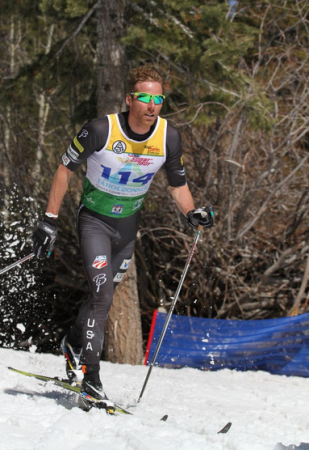
“I was with [Newell] up there and then I was so tired,” Ulsund said. “I was like, ‘OK, I’ve got to get to the finish line now.’ I knew those other guys were pretty far behind, so I just had to get up that hill. I just didn’t have any power left to follow Andy; he was pretty strong on that last hill.”
In the last 5 k, Freeman expanded his lead over Newell by another 20 seconds — his final time showed a 53 second gap. When Newell skied over the line, Freeman was still there to congratulate him. This winter has been filled with high and low points for Freeman, and he was clearly happy to finish on a positive note and share a moment at the end of a long season with a teammate.
“It was really nice to get the top 10 in Canmore, then the blood-sugar problems at the Tour really derailed me for a long time, and because of that I’m just not going to do the Tour next year with the Olympics coming,” Freeman said. “There were highlights and there were lowlights, and I’m glad to just end it on a high note.”
Newell’s second-place finish is his best career 50 k championship and adds another accolade to one of the best seasons of his life.
“I’m psyched it was a good season,” he said. “The only thing I didn’t accomplish was getting on that podium, and I’m really hoping to do that more next year, for sure. But in general it was a great season; an improvement in my distance racing for sure.”
It was a stellar day for everyone through the top six finishers, in fact. Each of them in some way produced one of their best races of their careers. Ulsund, who finished half a minute behind Newell in 2:26:15.5, stayed with Freeman and Newell for an impressive amount of time. Knute Johnsgaard (Yukon Elite Squad/CAN) made a huge comeback in the last lap to move from behind Bjornsen, Hanneman and Elliott with 10 k left to finish in front of all three of them, five seconds ahead of Elliott in a sprint for fourth.
“I was seeded 35, so I was kind of in the back of the pack for most of the first part, but I think that might’ve helped me in the long run, just to take it out kind of easy and build throughout the race,” Johnsgaard said. “I was just picking people off one by one and I just managed to catch Tad right in the finish. I’m really happy.”
Though Johnsgaard nipped him at the line, fifth is Elliott’s career-best classic 50 k result. In terms of pure effort output, he said his last lap of the course on Thursday took second to only his World Championships relay leg earlier this season.
“That last lap I was dying,” Elliott said. “That’s one of the deepest I’ve gone. That and the relay in Italy are the deepest I’ve gone.
Hanneman, who finished 39 seconds behind Elliott for sixth in 2:29:17.6, might have to start thinking about becoming a distance skier after Thursday’s result. The experience of racing his second major 50 k and winding up as the fourth American appeared to slightly confound the sprinter afterwards.
“I feel good, I mean, it’s just that’s not really my race,” Hanneman said. “I never put a move on. But instead of letting yourself just crumple you just try to keep going, and in this race that serves as a move.”
As to whether he’ll start thinking seriously about distance races in the future, Hanneman wasn’t sure.
“God, I hope not,” he said. “I don’t want to have to do that more than just as a consolation prize race at the end of the season. But maybe I will.”
Seventh went to Torin Koos, who finished 11 seconds behind Hanneman. O’Brien faded to eighth, 24 seconds behind Koos, and Trygve Markset (University of Denver) took ninth another three seconds back.
As for the ski change component, there were mixed feelings about it in the field. Freeman, for one, didn’t think it belongs in a national-level race.
“I’m a little torn on whether or not we should do ski exchanges, because it does tax the wax staff,” Freeman said. “I have to really thank my team. I had my entire team out there feeding me and I had my entire team working on the wax…It kind of makes it harder and I don’t think we want domestic racing to end up being a wax tech challenge. So I’m a little torn on ski exchanges. Actually, I’m not torn — I don’t like ‘em. It can make the race easier but I just think it’s too much.”
With the season officially over, athletes will take breaks from skiing in varying ways before they begin training again for next year. Newell is headed to Costa Rica to surf for a few weeks while Freeman will be relaxing at a yoga retreat.
“I’m going to take three weeks off and then start training again,” Freeman said. “I’m going home and then my girlfriend has talked me into going to a Kripalu yoga retreat, so I’m going to come out really zen for my next training block.”
— Alex Matthews contributed reporting.
More race photos available from MacBeth Graphics.
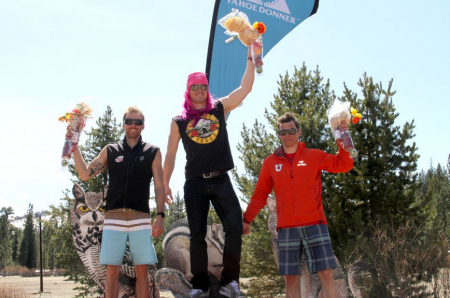
Audrey Mangan
Audrey Mangan (@audreymangan) is an Associate Editor at FasterSkier and lives in Colorado. She learned to love skiing at home in Western New York.




2 comments
trski
April 12, 2013 at 10:05 am
“Rags to riches or so they say……Ya gotta keep pushin’ for the fortune and fame….It’s all a gamble when it’s just a game….Ya treat it like a capital crime…Everybody’s doin’ the time”
Sweet reference to GnR on the podium!
petenewell
April 12, 2013 at 11:20 am
I admire Freeman’s honesty about the advantage enjoyed by skiers with professional service teams. I agree with his statement ” I don’t think we want domestic racing to end up being a wax tech challenge.”
Doesn’t it make sense to have the playing field be as level as possible, especially given that these races are an important opportunity for skiers without ‘advantages’ to work their way up to the US and/or Olympic teams?